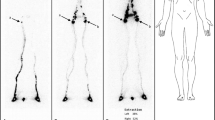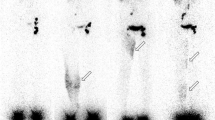Abstract
The aim of this work is to explore the patients operated on for a femoro popliteal bypass (FPB) with lymphoscintigraphy (LS) of the lower limbs. Data concerning 35 limbs from 33 patients operated on for a FPB have been included in a prospective study. Superficial and deep LS have been performed by injecting 74 MBq 99mTc-Rhenium Sulphide Colloid into the subcutaneous tissue of the first interdigital space and of the lateral malleolus region respectively. Both superficial and deep LS have been performed before and after surgery. A postoperative oedema was found in 17 of the 35 limbs. The value of the lymphatic flow indices and their varation after surgery do not significantly differ between the oedematous and non oedematous groups. Thirteen of the 17 limbs with oedema have presented an interruption of the lymphatic circulation or a diffuse activity outside the lymphatic vessels on the post-operative superficial and/or deep LS. This proportion is only 1/18 in the non oedematous group. The difference between the two groups is highly significant (P>0.001). By contrast, the proportion of lymph cyst does not differ significantly between the two groups. In conclusion, this study confirms the close relationship between the oedema following FPB and surgical damage to the lymphatics.
Similar content being viewed by others
References
Bomanji J, Baskerville P, Carroll MJ, Britton KE (1986) Lymphangioscintigraphy in patients after femoro-popliteal bypass. Nucl Med Commun 7:323 (abstr)
Campbell H, Harris PL (1985) Albumin kinetics and oedema following reconstructive arterial surgery of the lower limb. J Cardiovasc Surg 26:110–115
Eickhoff JH, Engell HC (1982) Local regulation of blood flow and the occurrence of edema after arterial reconstruction of the lower limbs. Ann Surg 195:474–478
Eickhoff JH (1984) Forefoot capillary filtration rate measured during lowering in normal subjects and in patients with occlusive arterial disease before and after arterial reconstruction. Clin Physiol 4:321–331
Eickhoff JH (1985) Normalization of local blood flow regulation in the ischemic forefoot after arterial reconstruction. Surgery 97:72–81
Eickhoff JH (1986) Local regulation of subcutaneous blood flow and capillary filtration in limbs with occlusive arterial disease. Dan Med Bull 33:111–126
Fernandez MJ, Davies WT, Tyler A, Owen GM (1984) Post-arterial reconstruction edema, are lymphatic channels to blame? Angiology 35:475–479
Franco A, Comet M, Beani JC, Doucet J, Meaulle PY, Guidicelli H (1980) La lymphoscintigraphie indirecte Son intérêt pour le diagnostic étiologique des oedèmes des membres inférieurs de cause non générale. J Biophys Med Nucl 4:299–303
Hannequin P, Clément C, Nicaise H, Valeyre J (1987) Exploration du systéme lymphatique profond des membres inférieurs par lymphoscintigraphie. J Biophys Biomec 11:23–27
Kleinhaus E, Baumeister RGH, Hahn D, Siuda S, Büll U, Moser E (1985) Evaluation of transport kinetics in lymphoscintigraphy: Follow-up study in patients with transplanted lymphatic vessels. Eur J Nucl Med 10:349–352
Melberg PE, Styf J, Biber B, Hasselgren PO, Korner L, Seeman T (1984) Muscular compartment pressure following reconstructive arterial surgery of the lower limbs. Acta Chir Scand 150:129–133
Porter JM, Lindell TD, Lakin PC (1972) Leg oedema following femoropopliteal autogenous vein bypass. Arch Surg 105:883–888
Stewart G, Gaunt JI, Croft DN, Browse NL (1985) Isotope lymphography: a new method of investigating the role of the lumphatics in chronic limb oedema. Br J Surg 72:906–909
Storen EJ, Myhre HO, Stiris G (1974) Lymphangiographic findings in patients with leg oedema after arterial reconstructions. Acta Chir Scand 140:385–387
Stranden E, Kramer K (1982) Lymphatic and transcapillary forces in patients with edema following operation for lower limb atherosclerosis. Lymphology 15:148–155
Stranden E (1984) Edema in the lower limb following arterial reconstruction for atherosclerosis. J Oslo City Hosp 34:3–10
Sty JR, Boedecker RA, Scanlon GT, Babitt DP (1979) Radionuclide “dermal backflow” in lymphatic obstruction. J Nucl Med 20:905–906
Toti A, Bresadola F, Mannela P, Bagni B, Gandini GC, Bighi S, Malavasi F (1978) Interstitial lymphoscintigraphy for the visualization of deep lymphatic circulation in the lower extremities. Angiologia 30:24–30
Vaughan BF, Slavotinek AH, Jepson RP (1970) Edema of the lower limb after vascular operations. Surg Gynecol Obstet 131:282–290
Vieras F, Boyd CM (1977) Radionuclide lymphangiography in the evaluation of pediatric patients with lower-extremity edema: concise communication. J Nucl Med 18:441–444
Author information
Authors and Affiliations
Rights and permissions
About this article
Cite this article
Hannequin, P., Clément, C., Liehn, J.C. et al. Superficial and deep lymphoscintigraphic findings before and after femoro popliteal bypass. Eur J Nucl Med 14, 141–146 (1988). https://doi.org/10.1007/BF00293538
Received:
Issue Date:
DOI: https://doi.org/10.1007/BF00293538




